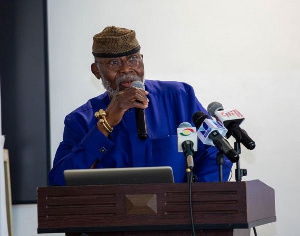Opinions of Tuesday, 20 August 2013
Columnist: Quaah, Amos Ofori
Why Nuclear Power Stations are not Suitable for Ghana
Seismological Reasons Why Nuclear Power Stations are not Suitable for Ghana
By Dr A. Ofori Quaah, Flitwick, England
(This is a lightly more technical version of an article I published a few weeks ago. It has been re-cast to put some seismological issues raised in the right context.)
“Building a culture of prevention is not easy. While the costs of prevention have to be paid in the present, its benefits lie in a distant future. Moreover, the benefits are not tangible they are the disasters that did not happen”. Kofi Annan, 1999 Former Secretary General, United Nations
(Unfortunately, the occurrence of earthquakes is the one potential major threat to our national security and safety, that can undo everything we have achieved in terms of national development, but one that we know least and care least about.)
“Go to the ant, you sluggard. Consider her ways, and be wise.” (Proverbs 6:6) INTRODUCTION Although major earthquakes are rare in West Africa as a whole, southern Ghana, and particularly the coastal towns and cities of Axim, Takoradi, Komenda, Feteh, Nyanyanu, Accra, Tema, Prampram and their surrounding villages, are subject to earthquakes, major ones having occurred in 1615, 1636, 1862, 1906 and 1939 as well as medium-sized ones in 1858, 1863, 1883, 1907, 1911, 1918-19, 1923, 1925, 1930 and 1933-35. In more recent times, earthquakes of magnitudes up to 4.9 have occurred in 1964, 1969, 1979, 1985, 1995 and 1997 (Figure 1). In addition, slight tremors are often felt by people in places like Kasoa, Weija, Nyanyanu and Feteh.
From late February 1973 when instrumental recordings began in the country, there was on the average, one recorded small earthquake about every ten days, until the late 1980s when the microseismic activity seemed to have gone down. Admittedly, this could also be due to equipment problems or the intermittent shortage of recording materials.
There were no local records prior to 1858 of major earthquakes in the country. However, Ambrasseys and Adams (1986) published a table of West African Earthquakes in which records of Ghanaian earthquakes dating as far back as 1615, were included. It would therefore seem that the area occupied by present-day Ghana has always been associated with earthquakes.
Unfortunately, the occurrence of earthquakes is the one potential major threat to our national security and safety, one that can undo much of whatever we have achieved in terms of national development, but one that we know least and care least about.
HISTORICAL EARTHQUAKES
Until Ambrasseys and Adams (ibid) published their study of West African seismicity, the earliest recorded earthquake in Ghana was the event that occurred near Axim on 18th December 1636. The whole of the East Nzema District was reported to have been shaken badly in that earthquake. The buildings and underground workings of a Portuguese gold mine at Aboasi northeast of Axim were reported to have collapsed, burying many of the miners. The earthquake of 1615 was reported to have destroyed what was then Takoradi, Junner (1941).
On 10th July, 1862, a very severe earthquake shook Accra and the villages along the coast, particularly those to the east of Accra. Every stone building in what was then Accra was reported to have been razed to the ground. The Christianborg Castle (former seat of Government, as it was at the time) and all the forts in Accra were rendered uninhabitable. The shock was felt as far afield as Abidjan in Cote d'lvoire, Cutonou in Benin and Benin City in Nigeria.
In 1863, another earthquake, which may have been an aftershock of the 1862 earthquake, was felt in Accra. There are no details of these events but it would seem that they did not cause any damage or casualty. Junner (ibid.)
Subsequently, there seemed to have been a lull until 20th November, 1906 when, between 9:00 p.m. and 9:20 p.m., two severe shocks hit the eastern part of the country. Those events have since been located at Ho by Quaah (1980). The first shock was reported to have lasted 60 seconds and was more severe than the second one which appears to have lasted 30-40 seconds. Several but less severe shocks were felt in Accra after the initial ones.
Many government buildings were cracked as a result of the earthquakes of 20th November, 1906. Christianborg Castle, Usher and James Forts were reported to have suffered more than any of the government buildings of the time, but none of them was rendered uninhabitable. No casualties were reported and damage to even the poorer sections of Accra was slight. (Junner, ibid.)
The shocks, however, caused general alarm but little damage at Akropong, Aburi, Somanya, Kpong, Akuse, Nsawam and other places in and around the Akwapim Hills, and at Winneba and Cape Coast in the Central Region. The shocks were also distinctly felt in Kumasi and Sekondi. Because of their proximity to Togo, the shocks were felt at Atakpame, Palime, Lome, Assahoun and Anecho, Junner (ibid.).
By far, the most widely studied earthquake in Ghana is the one which occurred at about 7:20 p.m. on 22nd June, 1939. The shock was felt for 20-30 seconds in Accra. It was reported to have attained a magnitude of about 6.4 on the Richter scale. Quaah (1980) determined a value of 6.5 from European and American seismological observatory records of that earthquake.
The greatest damage to life and property occurred in Accra where 16 people died, 133 were injured, and hundreds of thousands of pounds worth of damage was done to buildings. One person was killed and two injured at Oblogo, west of Accra and a few were injured in other towns and villages. Fortunately, the loss of life was smaller than might have been expected from the severity of the shock and the density of the population of Accra. (Junner, ibid.) This low casualty figure was reported to have been largely due to the fact that the shock occurred at a time everyone was awake and many were out of doors, and because there were no outbreaks of fire such as usually accompany severe earthquakes.
Even then, it would also seem that there were more casualties outside Accra than the resources of the then Geological Survey of the Gold Coast could cover, for in the course of research on later earthquakes, I met a lady whose father was killed by a falling wall at Cape Coast and an old man at Nyanyanu who told me that there certainly were deaths in that village. According to him nearly every mud building in the village was razed to the ground by the earthquake. The 1939 earthquake was felt by persons over an area of approximately 300,000 square miles, and at places more than 500 miles from Accra – as far afield as Lagos, Benin City and Port Harcourt in Nigeria. It was conjectured that, had the epicentre been on land, it would have been felt over an area of about 600,000 square miles, Junner (ibid.). Fishermen at sea at the time of the earthquake noticed a disturbance of the sea, what could have been a minor Tsunami.
The most recent and very widely reported earthquake series in Ghana occurred in early 1997. On January 8, at 7:40 am, February 14, at 11:30 pm, and March 6, 1997 at 3:17 p.m., earthquakes of magnitude 3.8, 4.1 and 4.8, respectively, hit southern Ghana. These earthquakes were centred west and northwest of Accra, each lasting between 10 and 15 seconds. While the first was only felt in Accra and surrounding villages and a few places in the Central Region, the latter two were felt in most parts of southern Ghana. At least the event of March 6 was felt as far west as Takoradi, as far east as Ho and as far north as Kumasi
These events were significant in the sense that they suddenly jolted the whole country to the reality of the seismic hazard in the country and the total lack of preparedness for a major earthquake on the part of even scientists and engineers, decision makers and the general citizenry.
Another worrying aspect of earthquakes in Ghana is the fact that they are usually followed by long periods of aftershocks. The earthquake of June 1939 was followed by thirteen months of aftershocks, often as many as five to seven in a single day, with magnitudes up to 4 on the Richter Scale (Junner,ibid) Even the relatively minor series of 1997 were followed by twenty–two aftershocks over a period of about eight weeks (Quaah,1999).
TECTONICS OF SOUTHERN GHANA
The structural history and tectonic framework of southern Ghana, particularly the Accra area, is of much interest to the tectonics of Africa, partly because of the seismicity of the Accra area, a hot spot within an otherwise calm region, and secondly, because of what is almost certainly a major geological boundary stretching from the coast west of Accra and continuing north¬eastward to Niamey in Niger (Figure 2).
Quaah (ibid.) deduced from fault plane solutions of the 1939 and 1969 earthquakes and a composite fault plane solution of a number of microearthquakes recorded between November 1978 and May 1979 that the Akwapim range, which he called "the Akwapim Fault Zone", is a fault scarp. He also noted that the zone is characterised by a series of recent normal faults which have rejuvenated an ancient system of faults. The fault plane solutions indicated normal movement along a number of normal faults with throws towards the southeast and accompanied by slight right lateral movements.
He concluded that, the right lateral component of the fault movements could be caused by east-west movements, possibly on the Coastal Boundary Fault. The presumed intersection of this fault system and the Akwapim Fault zone constitutes the weakest zone in the area. It is therefore not surprising that most of the microseismicity in southern Ghana is concentrated around that region.
However, this did not explain fully the historical epicenters around Axim, Takoradi and Komenda. Assuming that those earthquakes could be related to the Romanche Fracture Zone off the Tano-Cote d’Ivoire Basin, a detailed search was made of the United States Geological Survey Earthquake Database. The review only unearthed one small earthquake of Magnitude 3.2 near the Romanche Fracture Zone, several hundred kilometers off the coast of Ghana and Cote d’Ivoire. The conclusion was that the Coastal Boundary Fault, the exact location of which was not known with any certainty, was the fault responsible for the major historical earthquakes that affected the coastal towns of Ghana.
The Coastal Boundary Fault
Using long offset commercial seismic and satellite data, a detailed mapping of the Coastal Boundary Fault has been done (to be published.) The fault as mapped, runs about 25 kilometres offshore and along the whole coastline of Ghana, from Half Assini to Denu. Although there are no instrumental recordings (instrumental recording only began in the early part of the 20th century) or even isoseismal records to locate the historical earthquakes, inferences from scant ‘felt data’ indicate that seismologically, this has been one of the most active faults in Africa over the past 500 years.
Nuclear facilities
Of necessity, nuclear facilities must be located in areas with the availability of large quantities of cooling water, which in the case of Ghana, must be along the coast. Following the Fukushima, Japan earthquake, the International Atomic Energy Agency undertook a major study of the world’s nuclear facilities in relation to their proximity to major earthquake epicentres and concluded that the mean distance from a nuclear plant to the nearest earthquake of Magnitude 7 and above, is 785 miles (1868 km). The Coastal Boundary Fault is only 25 kilometres offshore, and the Akwapim Fault zone and its antithetic faults cover nearly half of the landmass of Ghana. In other words, by this worldwide criterion, no point on the coast of Ghana qualifies to be the site of a nuclear facility.
Additionally, large portions of the Coastal Boundary Fault have been locked up in the twin phenomena of seismic time and space gap for a very long time. Any major earthquake on any portion of the fault that causes a major displacement of the sea floor could trigger a Tsunami.
Because of the sensitivity of their operations, international Health and Safety regulations require that sites for nuclear installations are selected in such a way that risks to their employees and the general public are as low as practicable. Therefore nuclear facility sites must be areas of low population density that is evenly distributed around the site. In the course of planning, designing and supervising several onshore, near shore and marine seismic acquisition programmes as well as doing geophysical/geological field work in Ghana, I have travelled through nearly every fishing/coastal community along the coast of Ghana. It is mostly heavily populated. Short of removing and disrupting the lives of hundreds of thousands of people, no point of the coastal region of Ghana qualifies in terms of population density and local socio-economic activities, as a safe and viable location for a nuclear facility.
Cost implications
In view of the seimotectonic factors mentioned above, any nuclear facility in Ghana, if it is to be designed and built safely and securely will be prohibitively expensive. Equally prohibitive will be the socio-economic cost of moving and resettling large populations whose current already precarious existence on subsistence farming and fishing will be irreparably disrupted.
For our current level of development in terms of availability of manpower, economic self-sufficiency, transparency and accountability, as well as culture of maintenance, there are cheaper options in solar, wind, tide and biomass. Apart from Ghana’s own gas reserves, the West African Pipeline is now operational. Nigeria has enough gas to supply the whole of West Africa for 200 years! It takes only two to two and half years to construct and commission a gas power plant and about half the cost of a nuclear power plant which takes more than ten years to build. Apart from its sophistication, the cost of running and regular maintenance of a gas power plant is a fraction of that of a nuclear power plant. While we grapple with the problems of the maintenance and running of hydroelectric and gas power plants; while we labour to keep rubbish off the streets of our cities and towns; while we are at our wits end trying to fix an education system that is failing huge numbers of future leaders and while we struggle to provide water for domestic use, never mind for cooling nuclear plants, let us concentrate on the things we do best and leave more complex issues for future generations.
Public Hearings
If we must prepare for future nuclear experiments, then we have to begin by researching sites and preparing our people adequately for them. The issue of nuclear facilities is so profound that it cannot be left to the Ministry of Energy and the Ghana Atomic Energy Commission alone to discuss behind closed doors over coffee and biscuits, and foisted on the long-suffering people of Ghana. An independent group made up of the Geological Survey Department, NADMO and Lands Department should be constituted to hold open meetings with every town, village and hamlet along the coast of Ghana, to educate the people about exactly what is being planned, its benefits, its effect on their lives, the potential risks involved and what it will mean for generations unborn. These communities must be provided with independent expert advice at the expense of the state. Every community should be able to say “Not in my Backyard”, and their decision must be respected.
Subsequently, there should be durbars, workshops and symposia in every district and regional capital of the Western, Central, Greater Accra, Eastern and Volta Regions, to inform the people and canvas their views on nuclear power generation. Each of these units must be provided with independent expert advisers to explain issues in detail. Finally, there should be an honest national consultation exercise, followed by workshops, symposia and open debates over several years to ensure that the people understand exactly what is to be done in their name. That is what is done all over the world. We cannot have the current secrecy in a matter that could potentially change everything we have ever known for better or for worse.
Conclusion
In seismology it is said that “The longer it has been since the last major one, the closer it is to the next one.” All the factors that collectively led to major devastating earthquakes along the coast of Ghana in the past are still at play today. It is a geological principle that “The present is a key to the past.” As surely as night follows day, June 1939 will recur someday. Ghana and Accra especially, had not developed in 1939, as they are today. Accra’s population of 77,000 was a far cry from the current level of over a million. If we need a modern example to go by, Managua, Nicaragua, has still not been completely rebuilt from the devastating earthquake of 1972.
The cost of building, maintaining and running a nuclear power plant with its accompanying toxic waste, whether stored locally or elsewhere, will be too much for an economy that still depends on others’ hand-outs for crucial national policy objectives. Let us exhaust the available cheaper, safer and simpler options, and if we must, prepare the grounds for more sophisticated options, for future generations.
In the meantime if we have the resources, let us put them into educating our people about the effects of earthquakes and to retrofit certain national institutions.
Figure 1 Historical Earthquake Epicecntres, Modified Bondesen and Smit (1972 and Bacon and Banson (1979)
Figure 2 Akwapim Fault Zone and its relationship to the possible Pan-African Suture Zone
References
1) AMBRASSEYS, N.N. and R.D. ADAMS (1986) Seismicity of West Africa, Annales Geophysica, 4, B, 6, 679-702.
2) JUNNER, N.R. (1941) The Accra Earthquake of 22nd June 1939, Gold Coast Geol, Surv. Bull. 67pp.
3) QUAAH, A.O. (1980) Microseismicity, Past Seismic Activity and Seismic Risk in Southern Ghana, Unpublished Ph.D. Thesis, University of London, 224pp.
4) QUAAH, A.O (1999) Report on the Earthquake Series of 1999, Accra 1999, 42pp.
Entertainment









